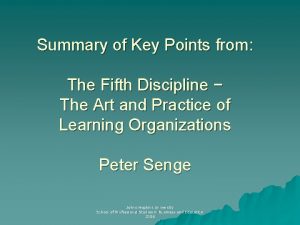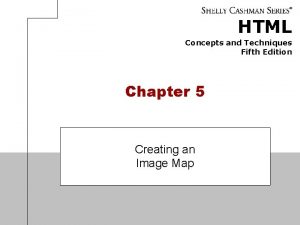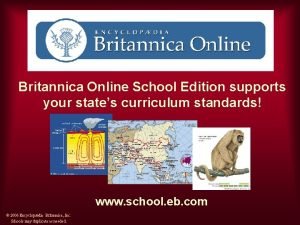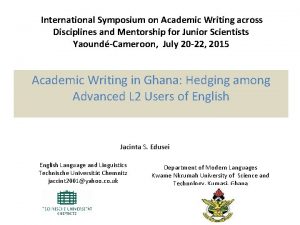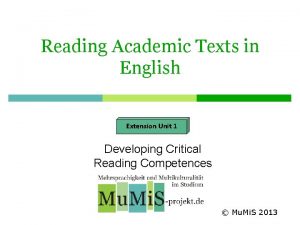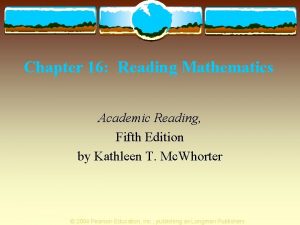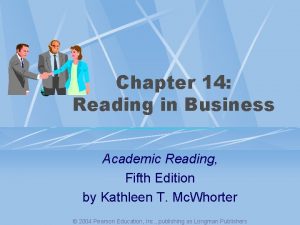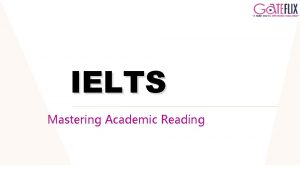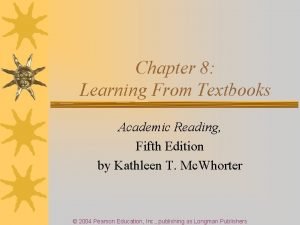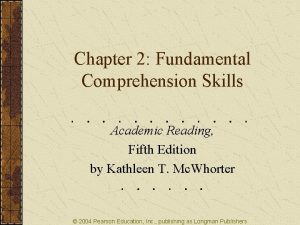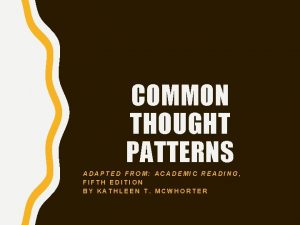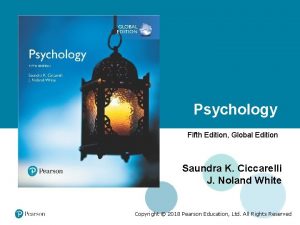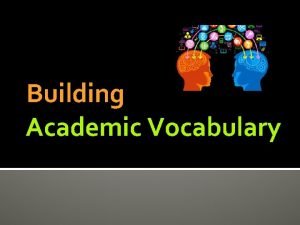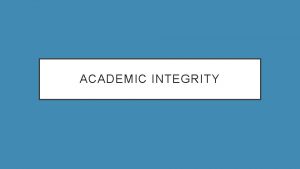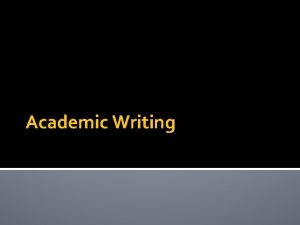Chapter 10 Reading Online Academic Reading Fifth Edition
















- Slides: 16

Chapter 10: Reading Online Academic Reading, Fifth Edition by Kathleen T. Mc. Whorter © 2004 Pearson Education, Inc. , publishing as Longman Publishers

Learning Objectives: t. To learn to locate electronic sources more effectively t. To evaluate Internet sources t. To read electronic text t. To develop new reading and thinking strategies for reading electronic sources © 2004 Pearson Education, Inc. , publishing as Longman Publishers

The Features of a Web Site t. A Web site is a location on the World Wide Web where you can obtain information on a particular subject. t. Each page is called a Web page. t. The first page is called a home page. t. Navigational buttons or icons allow you to move to different pages. t. Links are highlighted words that take you to other pages in the Web site. © 2004 Pearson Education, Inc. , publishing as Longman Publishers

Web Site Addresses t. A Web site has its own address or URL (Uniform Resource Locator). t. A browser program (Microsoft Explorer or Netscape Navigator) helps you find the site you want. t. Sometimes you need a name you use online, called a username, and a password to get started. © 2004 Pearson Education, Inc. , publishing as Longman Publishers

How to Locate Sources t. Identify Keywords t. Use Subject Directories (INFOMINE, Lycos, Yahoo) t. Use a Search Engine (Alta Vista, Web. Crawler, Infoseek, etc. ) t. Use a Meta-Search Engine (Meta. Find, Dog. Pile, PROFUsion) © 2004 Pearson Education, Inc. , publishing as Longman Publishers

How to Evaluate Internet Sources 1. Check the publisher or sponsor of the site. 2. Check the author for credentials. 3. Check the date of the posting for topicality. 4. Discover the purpose of posting. 5. Check the links to see if they work and are reputable. 6. Cross-check your information. © 2004 Pearson Education, Inc. , publishing as Longman Publishers

Why Electronic Text Requires New Reading Strategies t. Reading Web sites involves paying attention to sound, graphics, and movement, as well as words. t. Text on Web sites comes in brief, independent screenfuls, sometimes called nodes. © 2004 Pearson Education, Inc. , publishing as Longman Publishers

Why Electronic Text Requires New Reading Strategies t. Text on Web sites may not follow the traditional main idea, supporting details organization of traditional paragraphs. t. Web sites are multidirectional and unique; traditional text progresses in a single direction. t. Web site text requires readers to make decisions. © 2004 Pearson Education, Inc. , publishing as Longman Publishers

Why Electronic Text Requires New Reading Strategies t. Web sites allow readers the flexibility to choose the order in which to receive the information. t. Web sites use new symbol systems. t. Web sites have a wider variety of formats with color, animation, sound, music andperhaps words. Read slower, 25% slower! © 2004 Pearson Education, Inc. , publishing as Longman Publishers

Develop New Ways of Thinking and Reading t. Focus on Your Purpose t. Get Used to the Site’s Design and Layout t. Pay Attention to How Information is Organized t. Use Links to Find the Information You Need t. Explore Links t. Use Bookmarks and Favorites © 2004 Pearson Education, Inc. , publishing as Longman Publishers

Electronic Learning Aids t. CD-ROMs that accompany textbooks t. E-mail t. Newsgroups: forums to talk or chat with a group of people © 2004 Pearson Education, Inc. , publishing as Longman Publishers

How to Use a CD-ROM t. Try it out! t. Use them, but not in place of your text. t. Use as a chapter review. t. Use for review and practice and studying for exams. t. Use the notepad to add your notes. t. Space out your practice and consolidate your learning. Stop and reflect. © 2004 Pearson Education, Inc. , publishing as Longman Publishers

Summary Slides “How to Evaluate a Web Site” t The publisher or sponsor t Author t Date of posting t Links t Purpose of site © 2004 Pearson Education, Inc. , publishing as Longman Publishers

Summary Slides “How Web Sites Differ From Text” t Web sites involve graphics, sound, color, and animation. t Language t Screens on Web sites tends to be brief. are often independent of one another. t Web sites are multidirectional, require decision-making, and allow flexibility. © 2004 Pearson Education, Inc. , publishing as Longman Publishers

Summary Slides “How to Read Electronic Text” t Identify the purpose of the site. t Familiarize yourself with the site’s design and layout. t Pay attention to how the information is organized. t Use links to find additional information. © 2004 Pearson Education, Inc. , publishing as Longman Publishers

Now read the archeology articles and complete the exercises following the articles. “Slices of the Past” by Alan Hall “Archeology” by Tom Sever © 2004 Pearson Education, Inc. , publishing as Longman Publishers
 Principles of marketing fifth european edition
Principles of marketing fifth european edition Appraisals in lazarus's theory of emotion
Appraisals in lazarus's theory of emotion Fundamentals of corporate finance fifth edition
Fundamentals of corporate finance fifth edition Democritus atomic model diagram
Democritus atomic model diagram Molecular biology of the cell fifth edition
Molecular biology of the cell fifth edition Molecular biology
Molecular biology Human anatomy fifth edition
Human anatomy fifth edition Human anatomy fifth edition
Human anatomy fifth edition Using mis 10th edition
Using mis 10th edition Using mis (10th edition) 10th edition
Using mis (10th edition) 10th edition The fifth discipline summary
The fifth discipline summary Fifth chapter menu
Fifth chapter menu Pre reading while reading and post reading activities
Pre reading while reading and post reading activities School.ebonline.com
School.ebonline.com Britannica online school edition
Britannica online school edition Academic english reading and writing across the disciplines
Academic english reading and writing across the disciplines Types of academic text
Types of academic text










